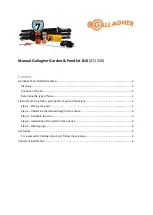
Subject to change without notice
12
can be used by the operator to save instrument settings
and to recall them. This relates to all settings with the
exception of
FOCUS, TR
(trace rotation) and the calibrator
frequency pushbutton.
SAVE:
Press the
SAVE
pushbutton briefly to start the save
procedure. The readout then indicates the letter
”S”
followed by a cipher between
1
and
9
, indicating the
memory location. If the instrument settings stored in this
memory location must not be overwritten, briefly press
the
SAVE
or the
RECALL
pushbutton to select another
memory location. Each time the
SAVE
pushbutton is
briefly pressed the memory location cipher increases until
the location number 9 is reached. The
RECALL
pushbutton function is similar but decreases the memory
location cipher until 1 is reached. Press and hold SAVE
for approx. 3 seconds to write the instruments settings
in the memory.
RECALL:
To recall a front panel setup, start that procedure by briefly
pressing the
RECALL
pushbutton. The readout then
indicates the letter
”R”
and the memory location number.
If required, select a different memory location as
described above. Recall the settings by pressing and
holding the
RECALL
pushbutton for approx. 3 seconds.
Attention:
Make sure that the signal to be displayed is similar to
the one that was present when the settings were
stored. If the signal is different (frequency, amplitude)
to the one during storage then a distorted display may
result.
If the
SAVE
or the
RECALL
pushbutton was depressed
inadvertently, briefly press both pushbuttons at the same
time or wait approx. 10 seconds without pressing either
pushbutton to exit that function.
Switching the instrument off automatically stores the actual
settings in memory location 9, with the effect that different
settings previously stored in this location get lost. To prevent
this, RECALL 9 before switching the instrument off.
Attention!
Both pushbuttons have a second function if the instru-
ment is switched to menu operation. Please note
”MENU”.
The setting controls and LED’s for the Y amplifiers,
modes, triggering and time base are located under-
neath the sector of the front panel described before.
(8) Y-POS. I
- Control knob.
The
vertical trace position
of channel I can be set with
this control knob. In
ADD
(addition) mode both (
Y-POS. I
and
Y-POS. II
) control knobs are active. If the instrument
is set to
XY
mode this control knob is
inactive
and the
X-POS.
knob must be used for a horizontal position shift.
DC voltage measurement:
If no signal is applied at the
INPUT CHI (26)
, the vertical
trace position represents 0 Volt. This is the case if
INPUT
CHI (26)
or in addition
(ADD)
mode, both
INPUT CHI (26)
and
INPUT CHII (30)
, are set to
GD
(ground) and automatic
triggering
(AT (10))
is present to make the trace visible.
The trace then can be set to vertical position which is
suited for the following
DC
voltage measurement.
Controls and Readout
by the signal‘s pulse duty factor.
In
DUAL
mode the
CURSOR
lines are related to the signal
which is used for internal triggering.
If the signal height is insufficient, the
CURSOR
lines do
not change.
(3) RM
The remote control mode can be switched on or off
(”
RM
” LED dark) via the
RS232
interface. On condition
that the ”
RM
” LED is lit, all electronically selectable con-
trols on front panel are inactive. This state can be left by
depressing the
AUTO SET
pushbutton provided it was
not deactivated via the interface.
(4) INTENS - READOUT
Knob with associated pushbutton and LEDs.
This control knob is for adjusting the A trace and readout
intensity. Turning this knob clockwise increases and
turning it counterclockwise decreases the intensity.
The
READOUT
pushbutton below is for selecting the
function in two ways.
If the readout
(RO)
is not switched off, briefly pressing
the
READOUT
pushbutton switches over the
INTENS
knob function indicated by a LED in the sequence:
Yt (time base) mode:
A - RO - A
XY mode:
A - RO - A.
Component Test:
A - RO - A.
Pressing and holding the
READOUT
pushbutton switches
the readout on or off. In readout off condition the
INTENS
knob function can consequently not be set to
RO
.
Switching the readout off, may be required if interference
is visible on the signal(s). Such interference may also
originate from the chopper generator if the instrument is
operated in chopped
DUAL
mode.
With the exception of the letters ”
CT
” all other
READOUT
information is switched off in
COMPONENT TEST
mode.
All
INTENS
settings are stored after the instrument is
switched off.
The
AUTOSET
function switches the readout on. The
INTENS
setting for each function is automatically set to
the mean value, if less intensity was previously selected.
(5) TR
The trace rotation control can be adjusted with a small
screwdriver (
please note ”trace rotation TR”
)
(6) FOCUS
This control knob effects both the trace and the readout
sharpness.
(7) SAVE / RECALL
The instrument contains 9 non volatile memories. These













































